A "Basic" Guide to SF Capture
Intro#

Have you ever wanted to be stepped on by Agent marry Agent? Yes? No? Well, either way, this is your chance. SF capture's here. Aka, protocol assimilation, aka coalition capture, aka whatever we decide to call it in EN.
Mastermind's gone, and now we're able to use those SF units that we have had to deal with for the last ever. No, I don't mean the Golyats. But hey, you get the ringleaders and stuff like Manticores.
You just need to brave the gacha mechanics to get these super cool and very-much-worth-the-trouble units. That last bit wasn't sarcasm either, they're insanely good. The only requirement to start this is that you need to have cleared 7-5 in the story. Once you've done that, you'll have access to coalition capture.
So let's cover all of the stuff related to this new system. Tl;dr at bottom. If you want to skip to it, click here. No, I don't recommend you just read that.
Protocol Control Center#
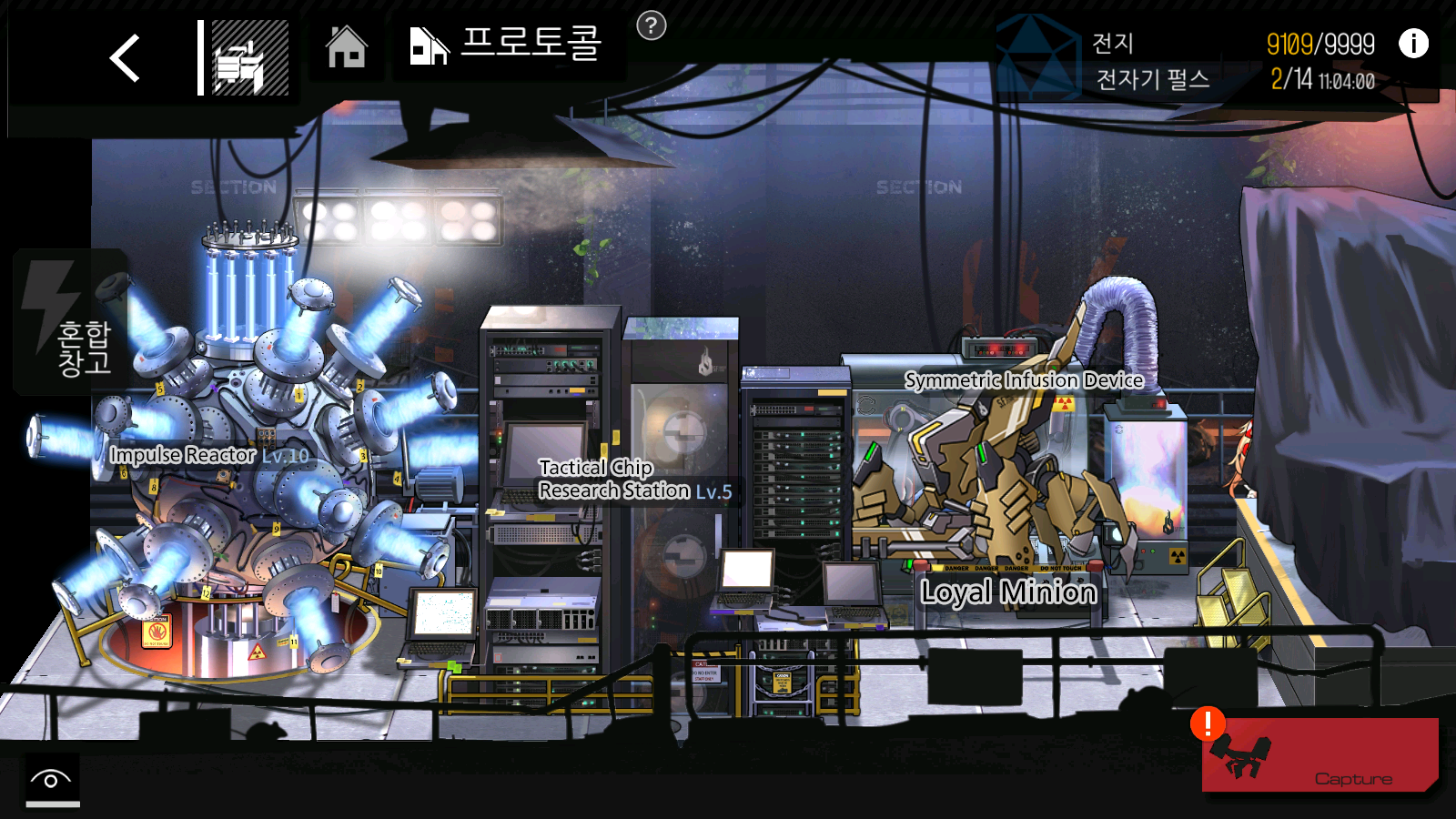
To start us off, we have the Protocol Control Center. This is the room where we'll be spending our batteries in order to get things rolling properly. For this room, we only have two structures we need to build, the Impulse Reactor and the Tactical Research Station. The third structure, the Symmetric Infusion Device, doesn't require any work to be done to it.
The most relevant structure to work on is the Impulse Reactor.

The amount of rolls you get per day for coalition units scales according to the level of the reactor, with the maximum number of daily rolls acquired at level 9. Going to level 10 isn't needed, but it does let you stockpile an extra roll if you so wish. So, getting to level 9 is your first priority.
Tactical Research Station#
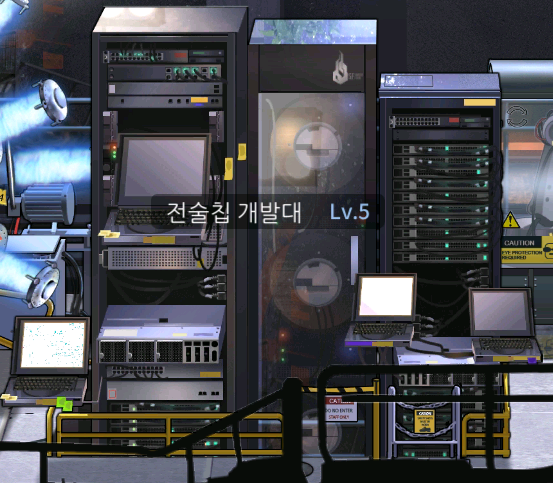
This lets you develop the chips used by the coalition ringleaders. It caps out at level 5, and you really don't need to prioritize working on it as the equipment it provides is mostly battery gated. I'll discuss the machine itself as well as the chips in it in a separate section. All you need to know right now is that you can focus on leveling this later, but you definitely want to do it at some point.
Symmetric Infusion Device#
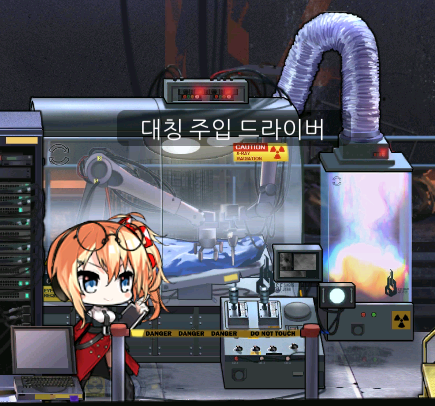
This lets you swap most attributes of a coalition unit with another one, like so:

So, in using this feature, you'll essentially take all of the listed stuff on the left and move it to the unit on the right. The stuff that gets transferred is: level, rarity, development, affection, and skill level. It'll take 50 catalysts to do the transfer. Note, this doesn't delete any of the units involved. The catalysts are obtainable largely from the kernel shop. What's a kernel shop? That has its own section so look at it there. It may not make too much sense right now as to the reason why you'd want to do this, but we'll get there. There's another tab on this menu, but it's largely unimportant. It's literally just for the situation where you get a shiny coalition unit and want to transfer that aspect of it to another unit of the same type for fifty catalysts. No, I'm not going to explain that one. It's pokemon, okay? Literally just shiny pokemon.
That about covers this room. For those who want to know, working on all the structures here will take 3,460 batteries to complete fully. Developing all the chips from the tactical research station will take 9,000 batteries. So, in total, if you want everything done ASAP, you'll need 12,460 batteries.
SF Capture #
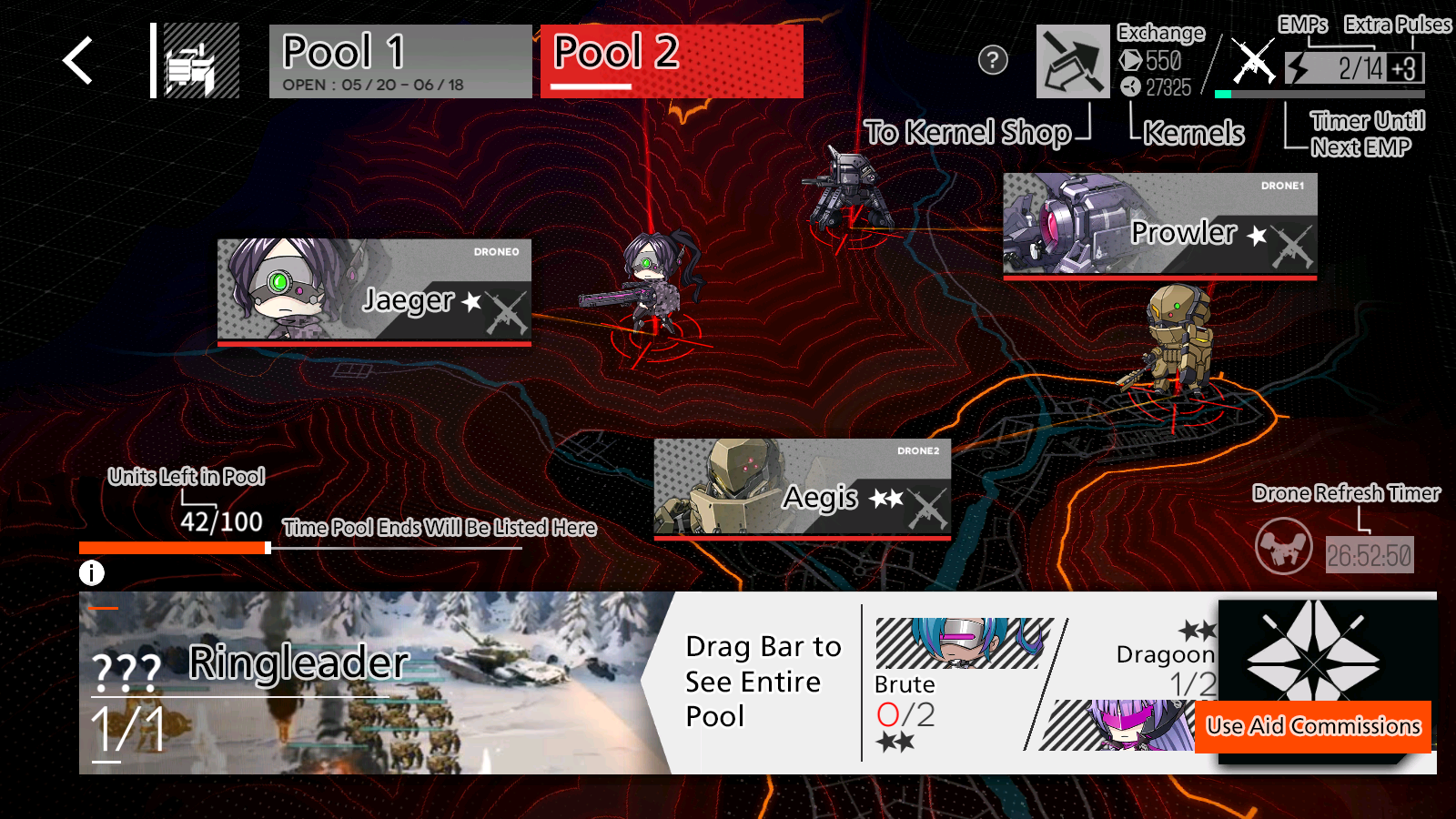
And now for the part I'm sure most people are here for: actually doing the coalition capture bit. The main screen for coalition capture can be accessed from the home screen, or from the Protocol Control Center. It'll take you to the screen above. Most of the screen is just going to be supplementary information; the main part is the middle area where you'll have three different coalition units on display. This is where you can pick and choose units to capture. Capturing these units will use up your EMP charges, which can be found on the top right corner. These charges regenerate over time and you can only store a limited amount of them. As mentioned before, these EMPs are the rolls that the reactor in the Protocol Control Center generates. At max level, the reactor will provide you an EMP every 12 hours and you can store up to 14 EMPs. These EMPs are not reset between specific banners for coalition capture, so if you wish, you can save your EMPs for the next banner.
You'll notice that there is a +3 next to the EMP count in the above picture. These are your extra EMPs, which I believe are called hyper-conductive pulses. They're essentially extra rolls you can infinitely store. These supercharged pulses are only used up once you go through all your EMPs and pull again with none left, so feel free to save them for a ringleader you desire.
Okay, so, you got some EMPs and you want to roll for some coalition units now, yeah? To do this, you can just tap on any of the available 3 units on the screen to attempt to capture them.
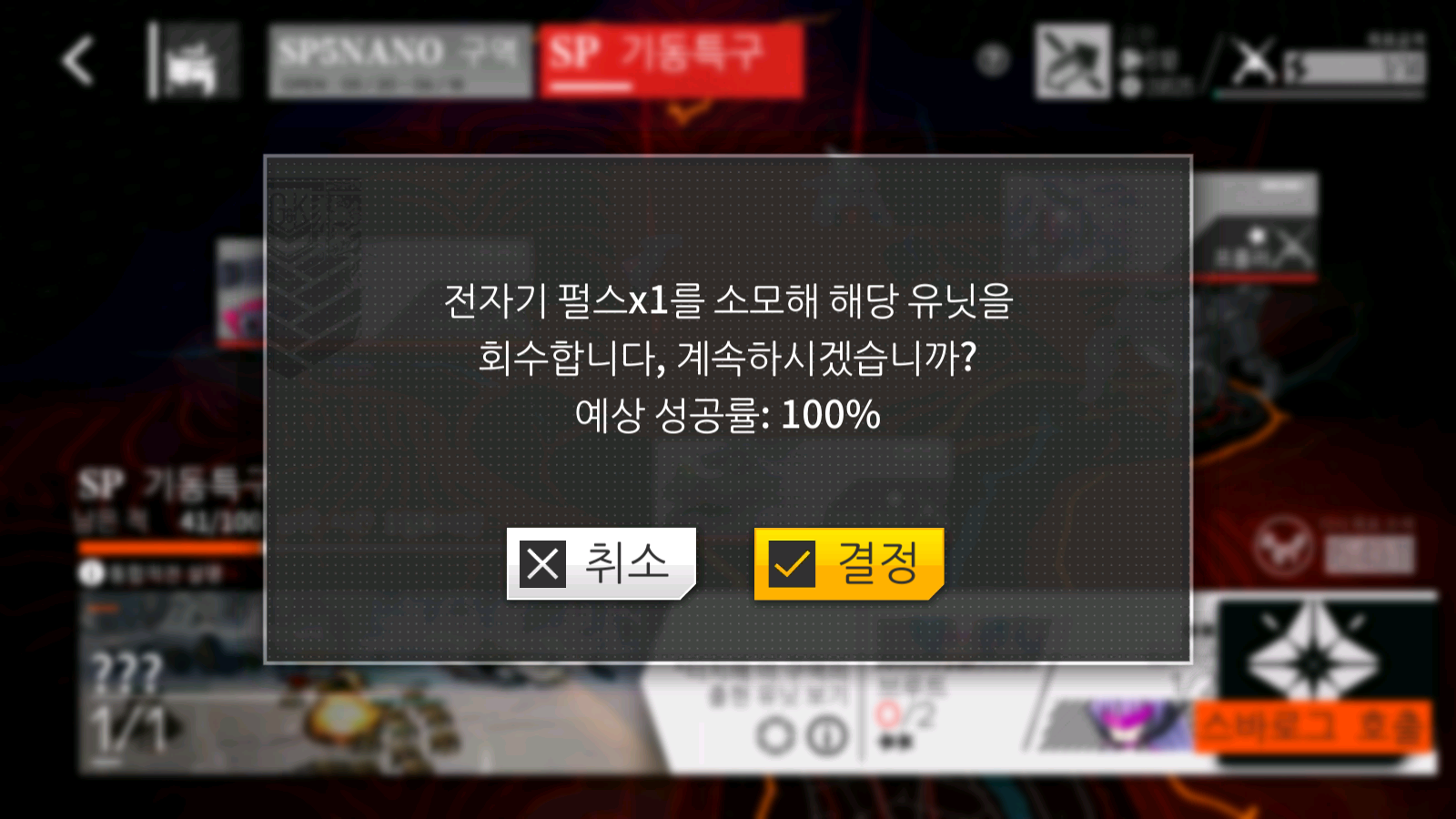
Different rarity units have different chances of being captured. 1* units have a 100% chance to be successfully captured, while 2* units have a 50% chance. 3* units (ringleaders) have a 25% chance of being captured. Not the best odds. But we out here. Anyway, once you select a unit you want to capture, you'll go through a cutscene of the capture. You can skip it if you so wish. Once you've gone through it though, you'll be presented with either a capture success or capture failure screen, like so:
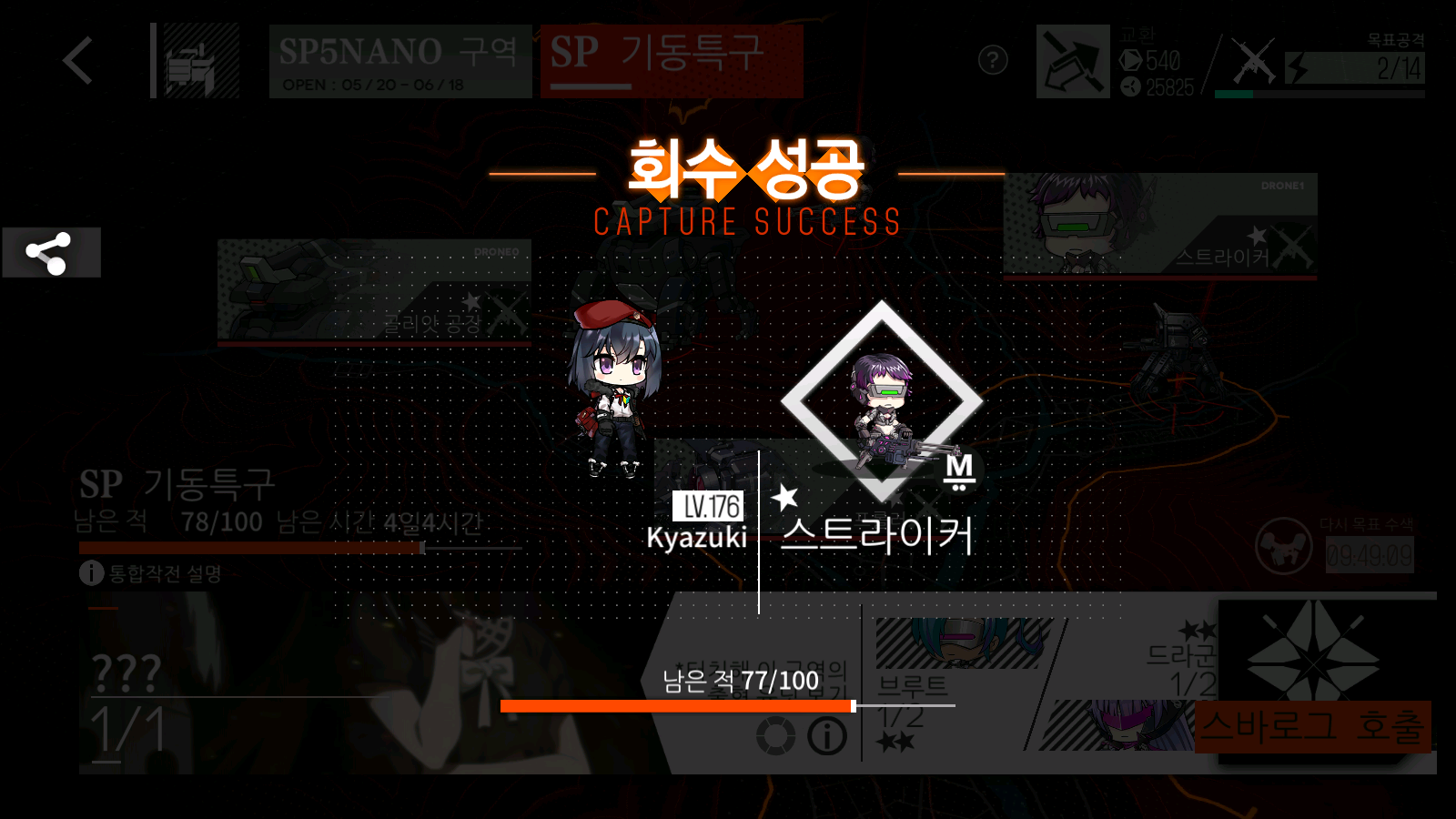
In case of failure, you'll instead get resources such as rapid enhancing discs, data, or things such as ammo. But, in a nutshell, that's coalition capture. I'm not going to tell you what I think is the best way to go about these as a free-to-play player, as I'm sure there's a multitude of methods to try and methodically go through a coalition pool. Speaking of coalition pool, it's time to explain the fine details of coalition capture.
Pools #
So, what I mean by coalition pool is that that there's a set of 100 units available to you each banner. This collection of 100 units usually gets referred to as "the pool". I believe it's typically divided up into 71 1* units, 28 2* units, and a single ringleader which is 3*. You can see the count of units in the banner at the bottom of the screen. The three units available for you to pull come from this pool. Successfully pulling a unit will remove it from the pool, while failing to do so will return the unit back to the pool. If you succeed in pulling a ringleader, you'll be given the option to reset the pool. This will refill the pool back to 100 units, just like it started as, and you can try and get another ringleader. You can decide not to, but it is recommended that you do reset when presented with the chance to. As a free-to-play player, you will not be able to pull the entire pool for every ringleader. Thus, getting ringleaders as a free-to-play is pretty random. Be very aware of this fact when considering when to use your aid commissions and extra pulses.
Aid Commissions#
You may be asking, what am I referring to when I say Aid Commissions, right? There's a third resource you can use to pull coalition units. These are officially referred to as Aid Commissions, but people may refer to them as Svarog Tickets. One of these tickets will pull a random unit from the pool at a 100% chance. This isn't just the three you see on the screen, but any unit out of however many units are left in the pool. You can use up to 10 at a time, and it works similar to most gacha game mechanics.
Using these are quite simple. Hit the button on the bottom right to bring the screen to use the tickets.
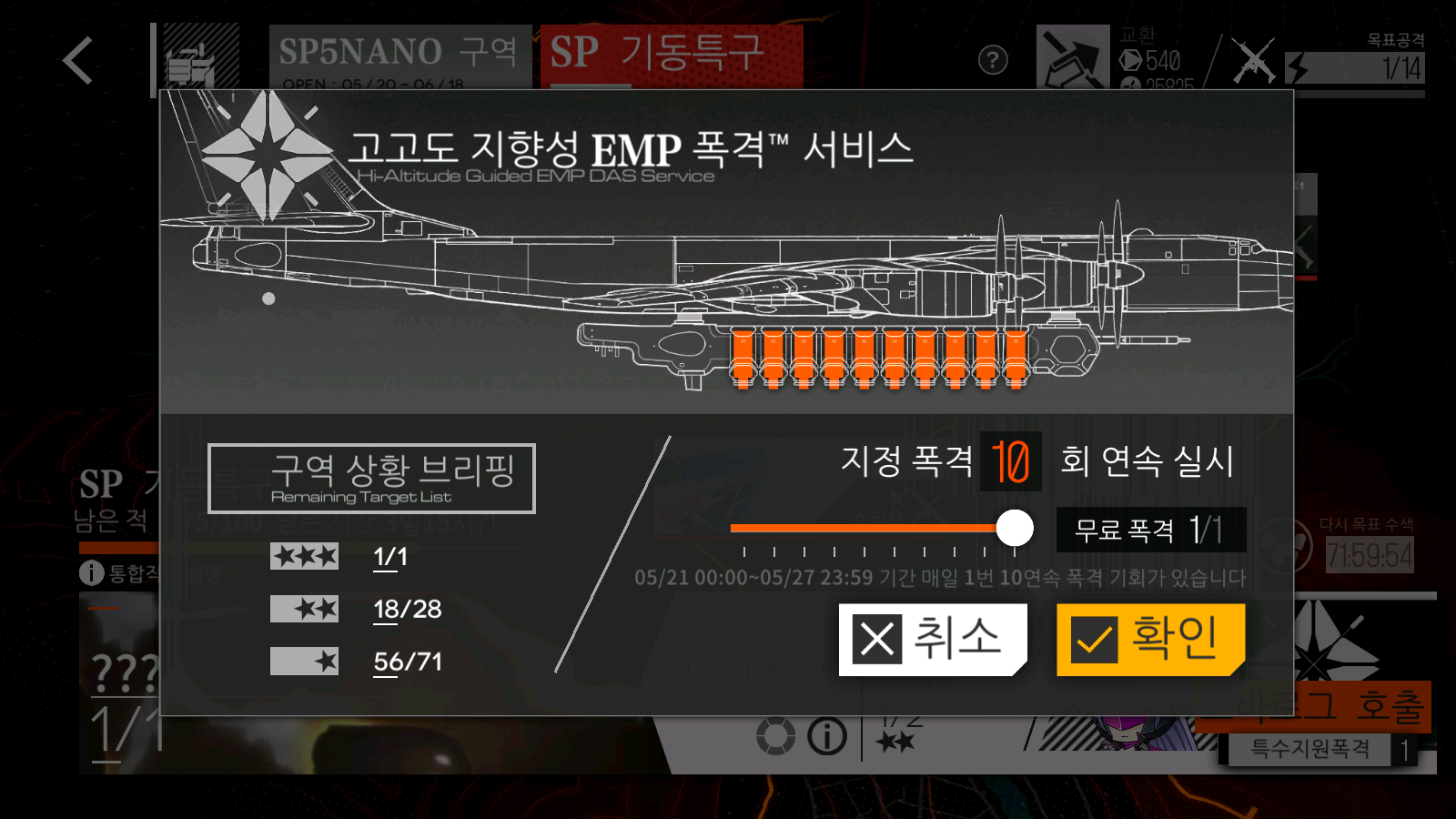
You may now use the slider to adjust how many tickets you wish to use. Hitting confirm will do the pulls, but you can cancel out if you change your mind. As I said before, there is a 100% chance to get a random unit for every ticket spent, no matter its capture rate on the map, and after the cutscene you'll be presented with your pulls.
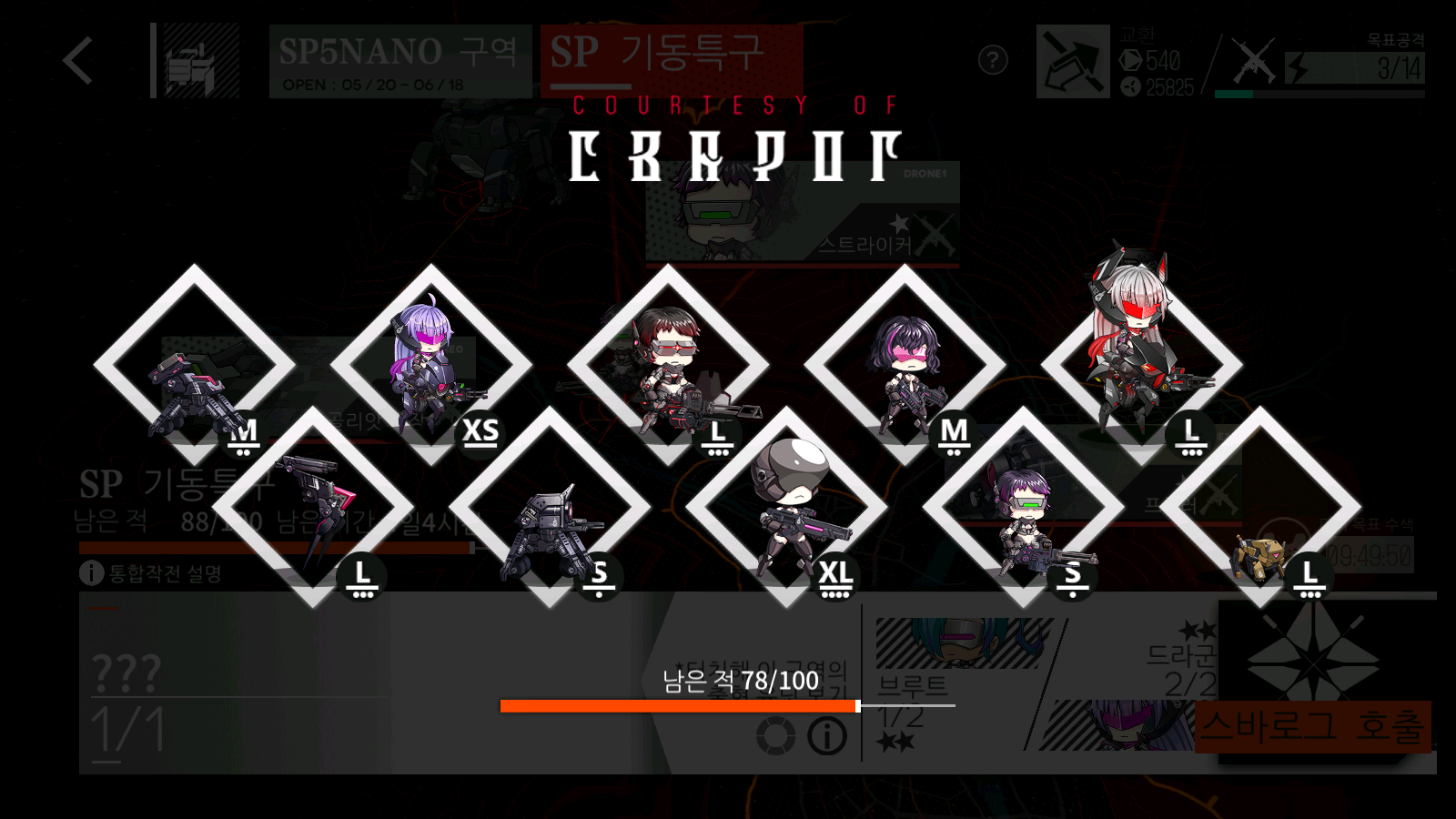
There's one last thing to cover here, but it has its own section below. On the top right, there's an exchange shop for kernels. Scroll down to the kernel shop section if you wish to know more, but that should wrap up this section.
Using Coalition Units#
Formations#
Okay, so you've got all of these units but what the fuck do you do to use them or how?
Simply put, all you need to do is create an echelon for them. The catch is that they can't be in the same echelon as any T-Dolls, though; they have their own unique type of echelon.
To create one of these echelons, just go over to any of your echelons that aren't in logistics/combat and try to change a T-Doll. You'll notice that there's a coalition tab available now.
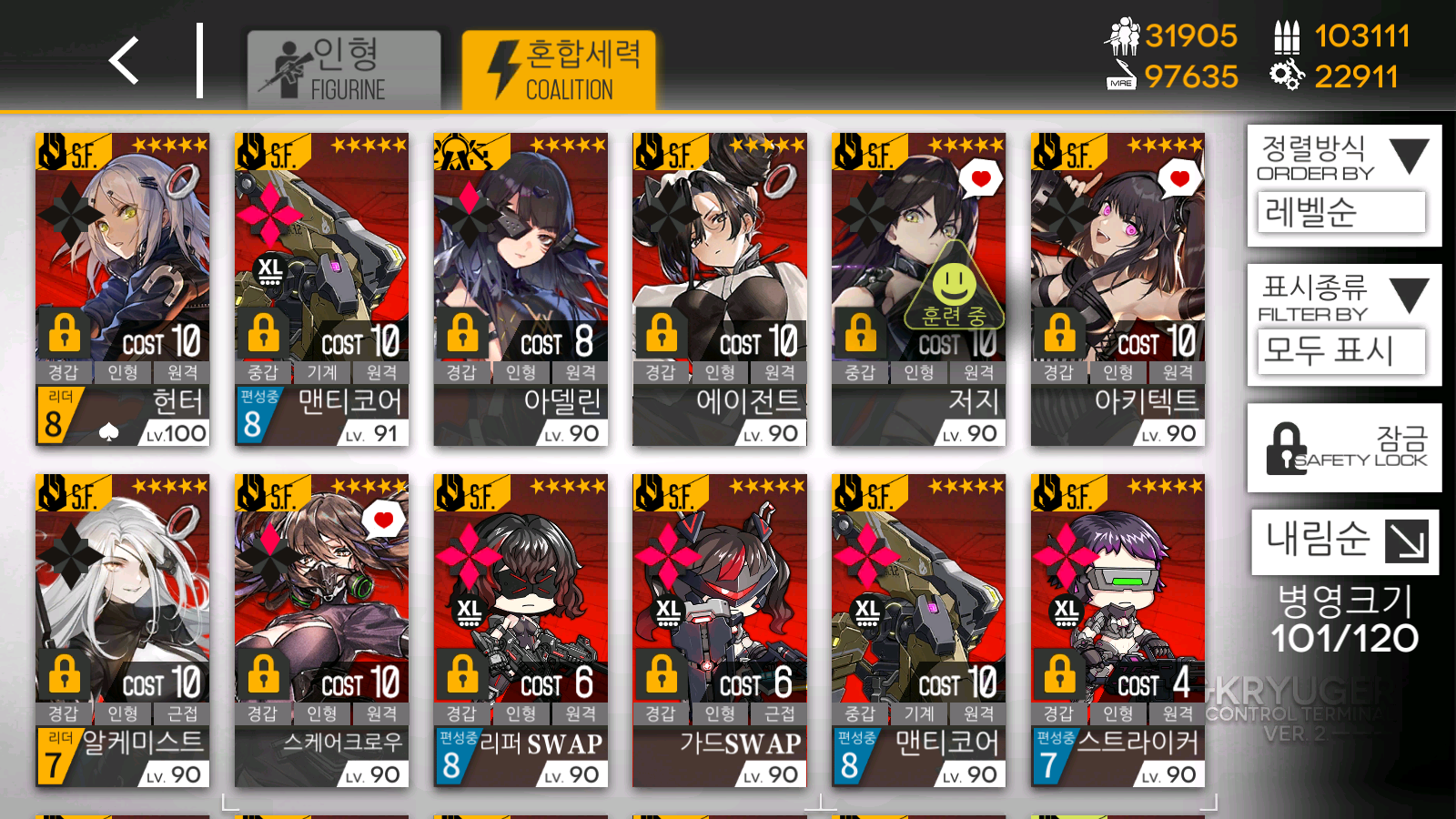
Selecting any of these coalition units to be used will give you a prompt asking you if you want to switch your echelon type to a coalition type echelon. Accepting this will convert it to a special echelon.
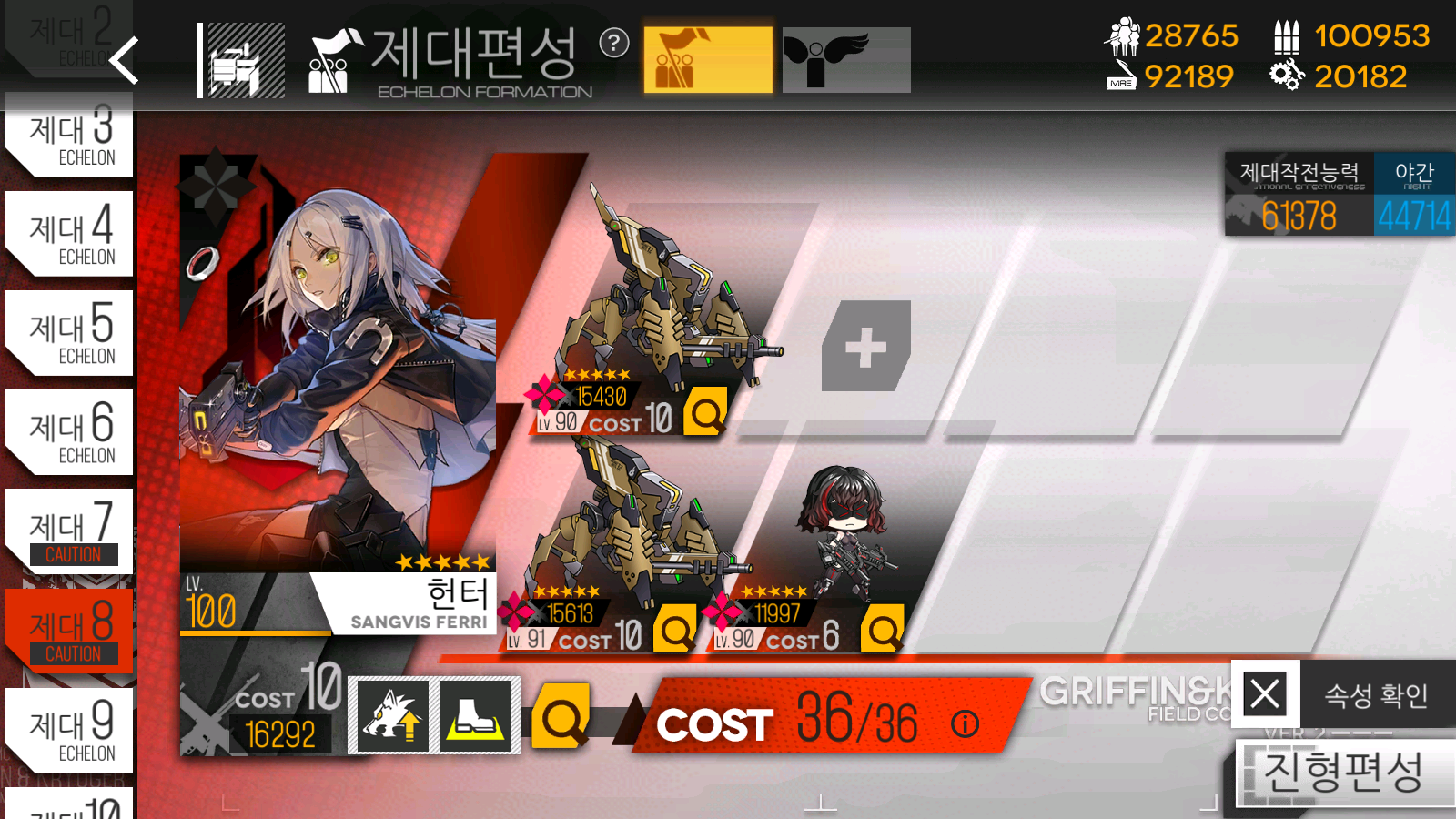
This is how you'll use your coalition units. You can now deploy them just like any other echelon. They do have some quirks, though.
For one, coalition units don't have any sort of equipment or fairies. The only type of thing that you can equip are chips. Chips are unique to ringleaders and they have their own section down below.
Second, you can have up to 9 units in an echelon. The only limitation potentially stopping you from doing this is the cost of each unit.
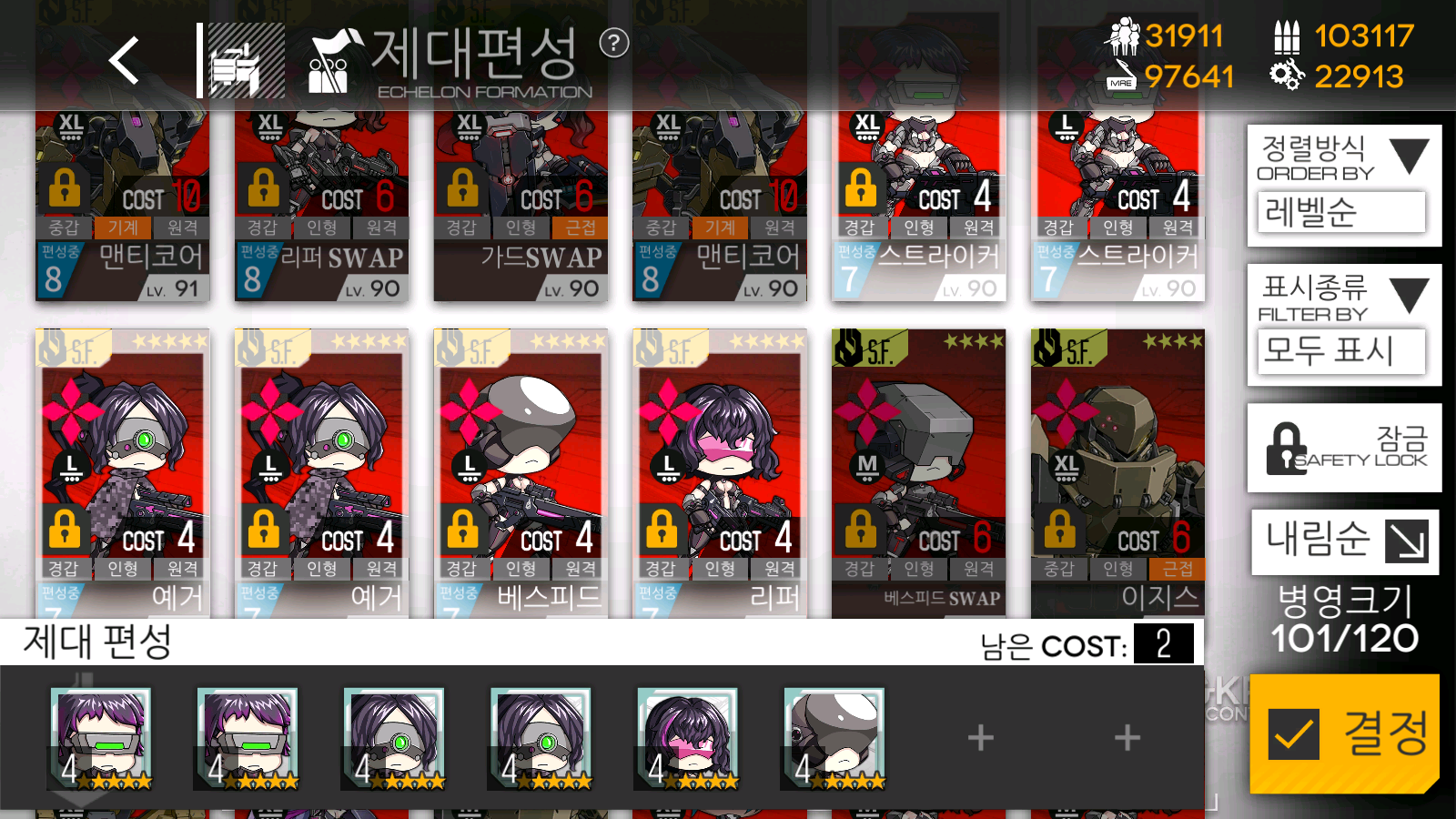
You have a limit of 36 cost per echelon, and each unit has a unique cost associated with it. Ringleaders usually cost 10, so that's already 10 of the 36 you can use up. Weaker units tend to have lower cost, so you can deploy more of them. Do note that you can only have ONE ringleader in an echelon.
Thirdly, when you deploy a coalition echelon, it will start with no supplies, period. Even if you retreat a fully supplied echelon on a heliport and redeploy it, it will start with no supplies. Those supplies are refunded, however, when you retreat an echelon when it's on a heliport or clear the map. This essentially means corpse dragging as we know it doesn't work for these echelons. Aside from this quirk, supplying/resupplying them works just like with regular echelons.
Fourth, coalition echelons don't need any special units to gain vision of adjacent nodes, unlike regular echelons and handguns. They innately have a 1 range vision around them at night.
Lastly, coalition echelons have only one source of tile bonuses, unlike normal echelons, which is ringleaders. They will buff all units in their echelon, no matter what tile they are on.
In combat#
Coalition echelons are a bit different from regular echelons in combat.
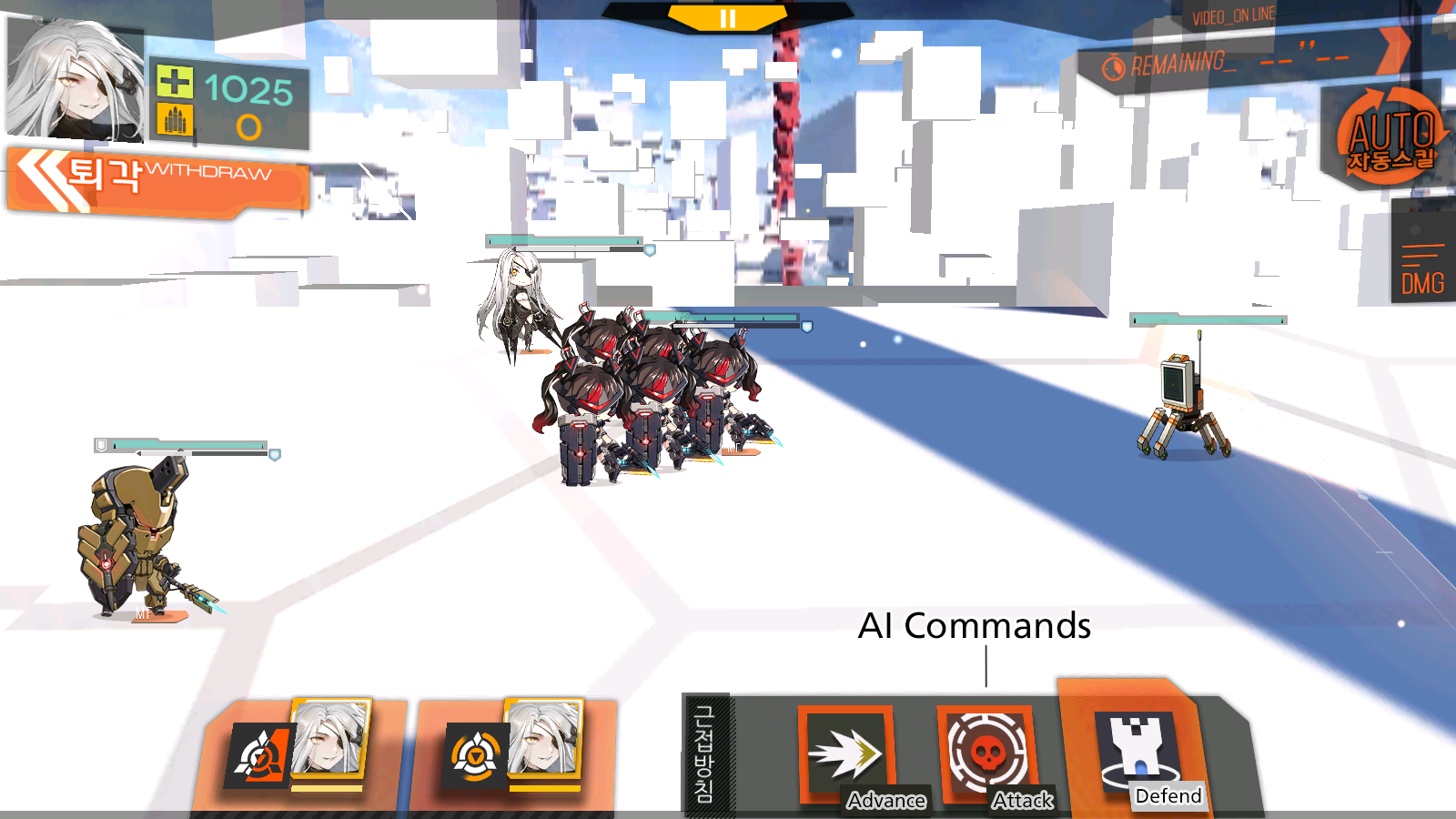
As you can see, this looks a bit different from what you'd see during combat when using T-Dolls. We only have two skills available here, with a completely new bar on the right to fill in the rest of the space there that would be empty otherwise. So let's go over some of the changes found in combat with these echelons.
First, why do we have only two skills available to use? This is because only ringleaders have active skills that you can make use of in battle. All the other units passively use their skills.
Second, what's up with the new bar? While we can micro our echelons just like normal echelons, we have an additional bar of AI settings, this is specifically for units that can melee. You'll have access to three different AI settings in combat: advance, attack, and defend. Advance makes all your melee units move forward. They'll move down the row they're currently on and will attack any enemies within range. If they encounter nothing, they'll advance until they decide to chill out, like so:
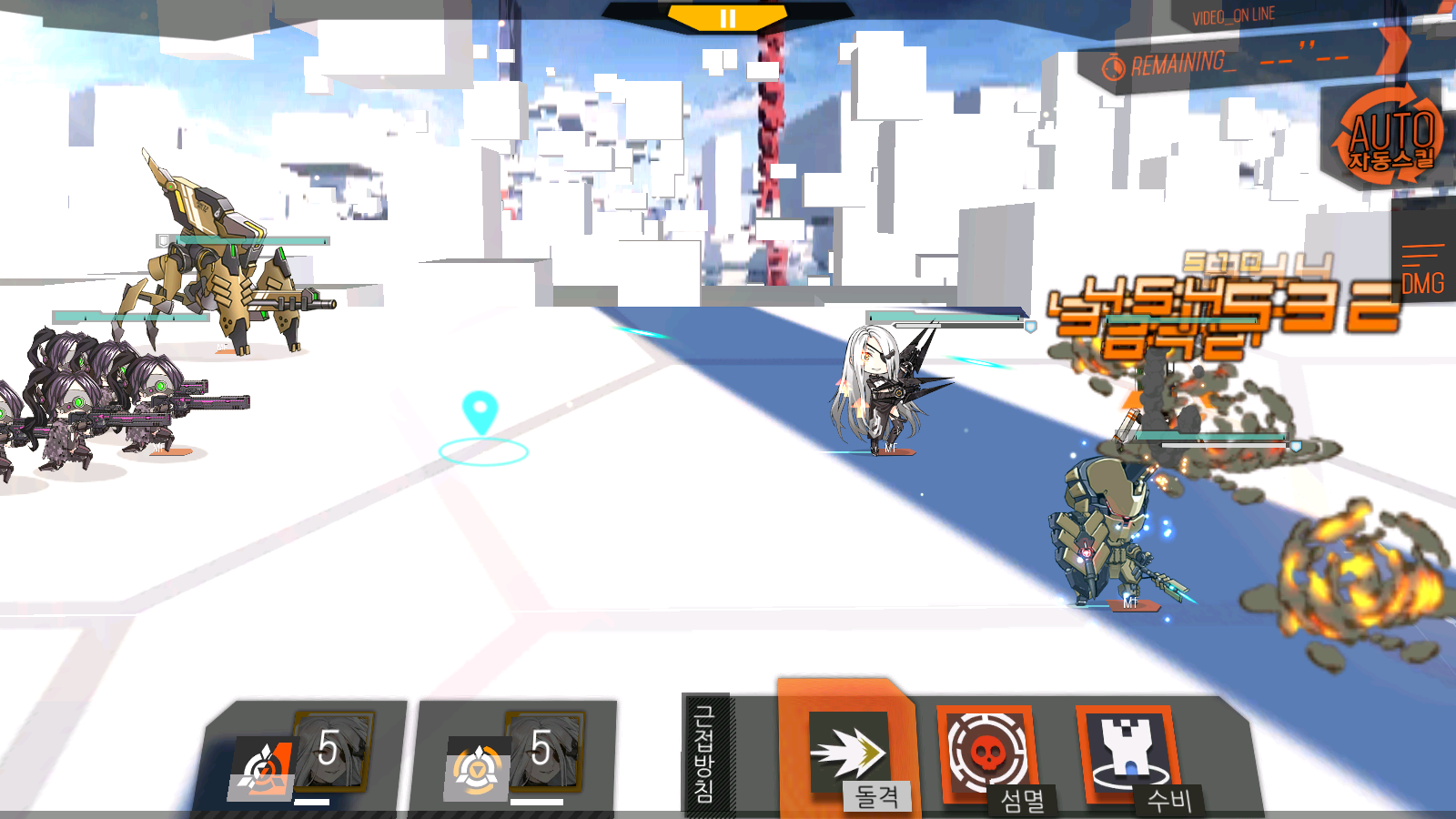
Note how the Aegis isn't attacking anything, as it just advanced down the bottom row without being in range of the target dummy. If you want to have it attack something properly, you'll have to set it to attack. This will send your melee units to engage the closest enemy, regardless of what row they start on.
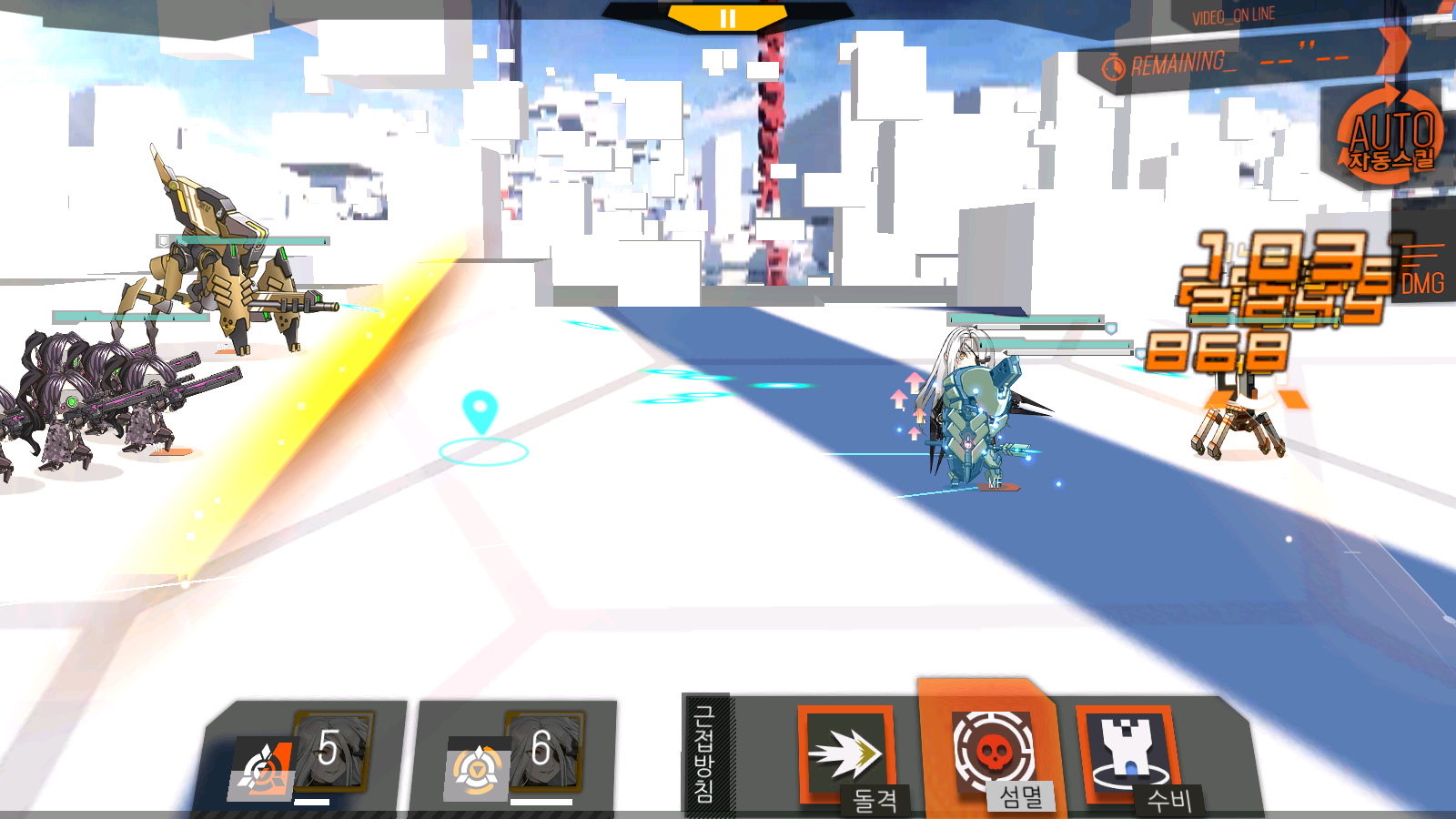
Okay, cool, so our melee units are able to actually fight now. But the problem is, when in either of those two AI states, you lose the ability to micro them as you would other units. If you want to, you can use the defend AI setting. This is the default AI setting for coalition units, and when you select it after using either of the other two AI settings, they will return to their tiles, where you can micro them.

Do note that even while the melee units are in the other two AI settings, you can pick and choose what tile you want them to return to after you hit defend again by doing the standard movement commands you'd do in a regular echelon.
Firing Range#
There's one more quirk to coalition echelons that should be noted. It seems small, but the way that the firing range for these echelons is determined is completely unlike regular echelons. They don't have set firing ranges, and you don't get a longer range by having a unit in the rightmost column of your formation. The only thing that changes your effective range is the firing range of the units in your echelon.
Each coalition unit has a different range, just like how different enemy types have different firing ranges. The way the firing range of your echelon is determined is purely based on the unit with the longest range in your echelon. Meaning, if you have a Jaeger in your echelon, all your other units will fire when enemies are within the firing range of that Jaeger. So, having a unit with good range is something you should consider when constructing echelons.
Raising Coalition Units#
Raising coalition units is much like raising regular T-Dolls. Just like regular T-Dolls, you can level them up, dummy link them, and level up their skills. However, enhancing coalition units is different. Regardless of similarity, I'll go through each of these things.
Leveling#
Leveling coalition units is more or less the same as it is with T-Dolls. However, you can't corpse drag them (yet). Right now, you either need to level your units through coalition rapid enhancing discs or running maps while paying the resources to resupply everyone in the echelon, which is going to be a pain, because they don't get an experience point multiplier like higher-linked T-Dolls do. The experience points needed to level them up is very similar to the amount needed for T-Dolls. Going to level 100 takes 1086 discs, while going to level 90 takes 656 discs. How you get the discs is explained lower down in the document. There's not much else to say about this right now. I'd recommend just using discs for leveling them up until we have other options.
Analyzing #
Dummy linking coalition units is called analyzing. You can access it through the factory in the same tab you would use to dummy link your T-Dolls. Selecting a doll to dummy link will bring up the usual screen where you select another doll to link it with, but you'll notice there's also now a coalition tab there. Tapping that will let you select a coalition unit to analyze.
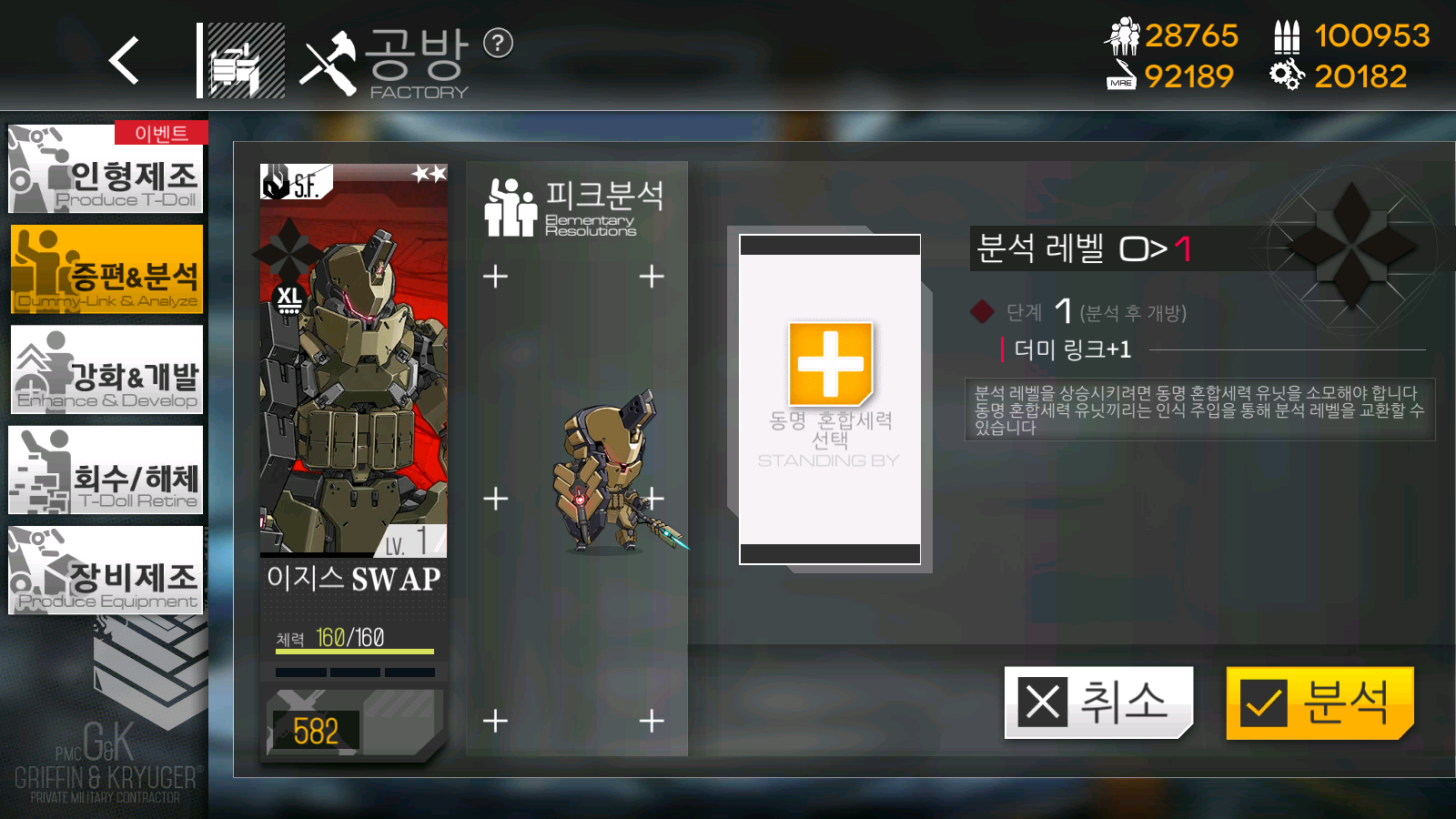
Analyzing is a process similar to dummy linking, but it doesn't strictly increase the amount of links a unit has. Most of the time it will, but sometimes it just gives stat bonuses to the unit. Unlike dummy linking you can ONLY analyze coalition units using duplicate copies of the unit itself. These duplicate units can be any size, so you don't need to use copies that are the same size as what you're analyzing. If you don't get what I mean by size, that's covered in the next section. The process can be started at any level without any downside, so don't worry too much if you don't have the duplicates available.
Ringleader Potentials#
If you're particularly astute, you may notice that ringleaders don't show up in the analyze tab. This is because while they have a system just like all the rest of the coalition units, any duplicates you get of them are automatically used. As mentioned, analyzing doesn't always provide dummy links for coalition units, and ringleaders follow that. Typically you'll get bonuses towards their tiles, stats, and skills. Ringleaders are fairly strong even without these bonuses, so don't worry about pulling dupes to improve them unless you're whaling/trying REALLY hard.
Development#
Development is sort of like enhancing T-Dolls, but it works much differently for coalition units. Each coalition unit inherently has stats that match their level. Meaning, you don't have to do enhancement for each level they gain like you would with T-Dolls or HOCs. However, there's two things that affect those stats.
First, they have their size. This is a trait inherent to every coalition unit you pick up that is decided when you roll them. If you notice, in the pictures that involve a coalition unit, they usually include something like XL or L or S. This is their size designation. The bigger the unit, the higher stats they'll have. Going from smallest to largest, this would be: XS->S->M->L->XL, with XL being the best, and XS being the worst. This can only be changed via the symmetric infusion device in the Protocol Control Center. Do note that XL and XS are both fairly rare, so holding out for an XL copy of a unit may not be the best course of action.
The second thing that affects a unit's stats is their rarity. This is what development affects. Each and every coalition unit can hit 5* rarity, which increases the stat limits the unit has, while also sometimes bringing other benefits, such as unlocking extra skills or changing their artwork. Once again, you can find this menu in the factory, this time under the same tab used for T-Doll enhancement. Attempting to select a T-Doll to enhance gives us a tab for coalition units as well. Selecting a coalition unit here will pull up the development for said unit.
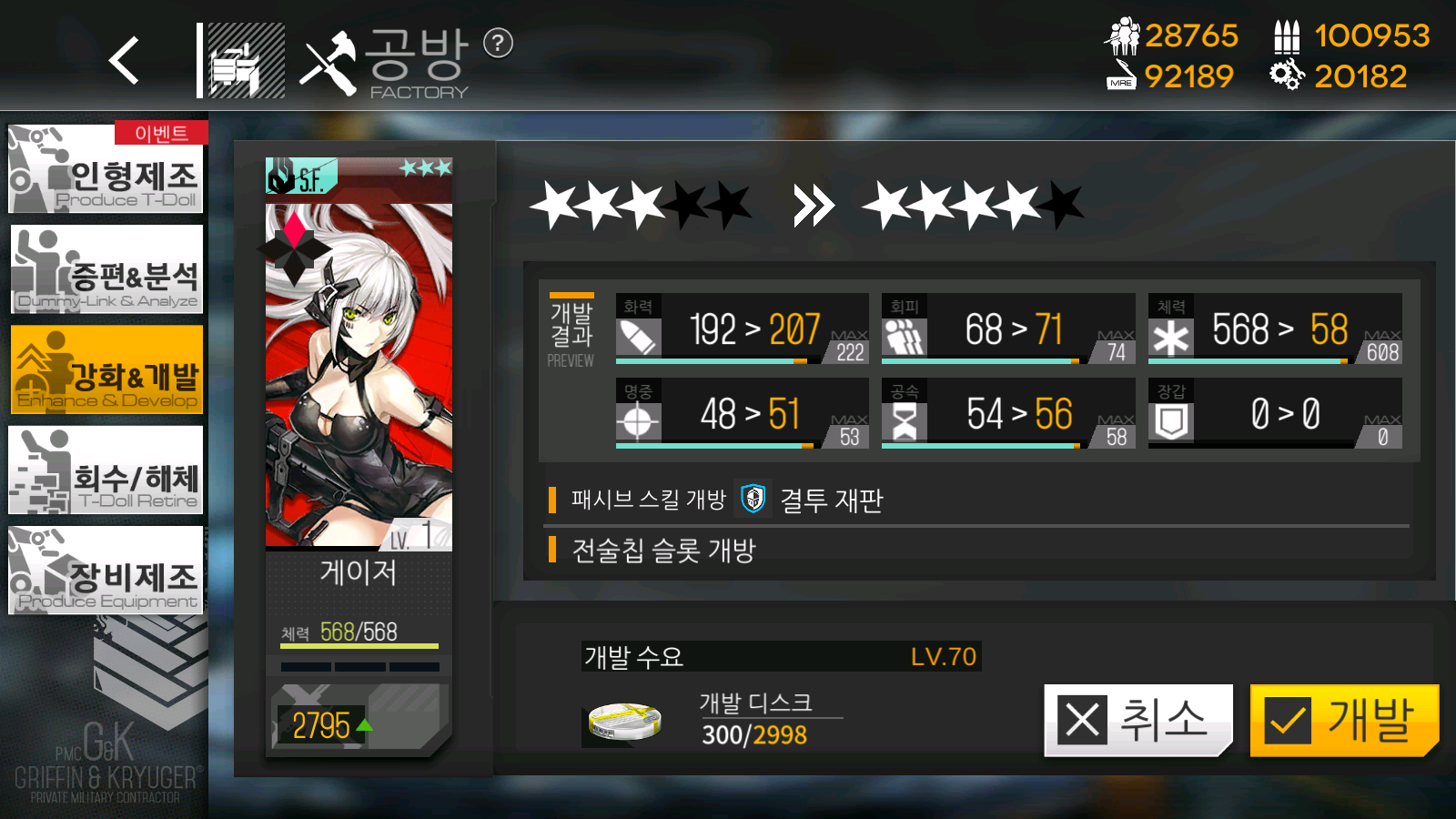
This process consumes petri dishes to increase the rarity of the unit. Do note that there are minimum levels required before you can upgrade to specific rarities. A table for petri dishes consumed as well as the level required for each rarity is provided here:
Coalition Development Table#
| Rarity | Level Required | Petri Dishes Used | ||
| 1* Initially | 2* Initially | 3* Initially | ||
| 1*->2* | 10 | 50 | - | - |
| 2*->3* | 30 | 70 | 100 | - |
| 3*->4* | 70 | 100 | 150 | 300 |
| 4*->5* | 90 | 200 | 300 | 450 |
| Total | 420 | 550 | 750 | |
Skill Leveling#
Skill leveling coalition units is also very similar to regular T-Dolls. They have their own unique data but otherwise it's the exact same process. Go over to research and now you'll have a third tab aside from T-Dolls and fairies just for coalition units. There are some minor differences between raising the skill level for these and how it works for fairies and T-Dolls, though.
The major difference is that units aside from ringleaders have zero training time for their skills.

Fairly nice. Their skills also max out at level 5, rather than 10, like other units do. The data costs per level are a bit higher though. Thankfully, they use their own unique type of data, as you can see in the above screenshot. Another unique thing to coalition units is that some have multiple skills. Units that start at 1* initially can only have one skill, while units that start at 2* initially have two skills. The second skill only unlocks once you upgrade them to 4* rarity through development.
Ringleaders are a special case that's separate from how other coalition units work. Ringleaders have four different skills to max out. Their first two skills are very much like T-Doll skills, as they take time to actually train, they also max out at level 10. Their third and fourth skills are similar to other coalition units, as they max out at level 5 without any training time needed.
Data consumption tables#
| Skill Level | Regular Coalition Unit Skills and Ringleader Skill 3 and 4 | |
| Data Type Used | Amount of Data Used | |
| Lv 1->2 | Orange(Basic Training Keycode) | 400 |
| Lv 2->3 | 1,000 | |
| Lv 3->4 | Red(Advanced Training Keycode) | 200 |
| Lv 4->5 | 600 | |
| Total Data used: | 1,400 Orange and 800 Red | |
| Skill Level | Ringleader Skill 1 and 2 | ||
| Data Type Used | Amount of Data Used | Training Length | |
| Lv 1->2 | Orange(Basic Training Keycode) |
300 |
1 hr |
| Lv 2->3 | 400 | 3 hr | |
| Lv 3->4 | 500 | 5 hr | |
| Lv 4->5 | 600 | 8 hr | |
| Lv 5->6 | 800 | 12 hr | |
| Lv 6->7 | Red(Advanced Training Keycode) | 200 | 16 hr |
| Lv 7->8 | 300 | 20 hr | |
| Lv 8->9 | 400 | 27 hr | |
| Lv 9->10 | 600 | 36 hr | |
| Total Data used | 2,600 Orange and 1,500 Red | ||
That covers about everything for raising coalition units.
Coalition Drills#
...Or does it? You may have read that entire previous section and wondered "where the fuck do I even get all the stuff needed to raise them?" Well, to answer your question, you need to do combat sims. Introduced with SF capture, we have a new type of combat sim. No, thankfully we don't need to worry about being deprived of energy for our T-Dolls, as these sims use a different type of energy. Head on over to the combat sim tab in the combat menu to find the new sims.
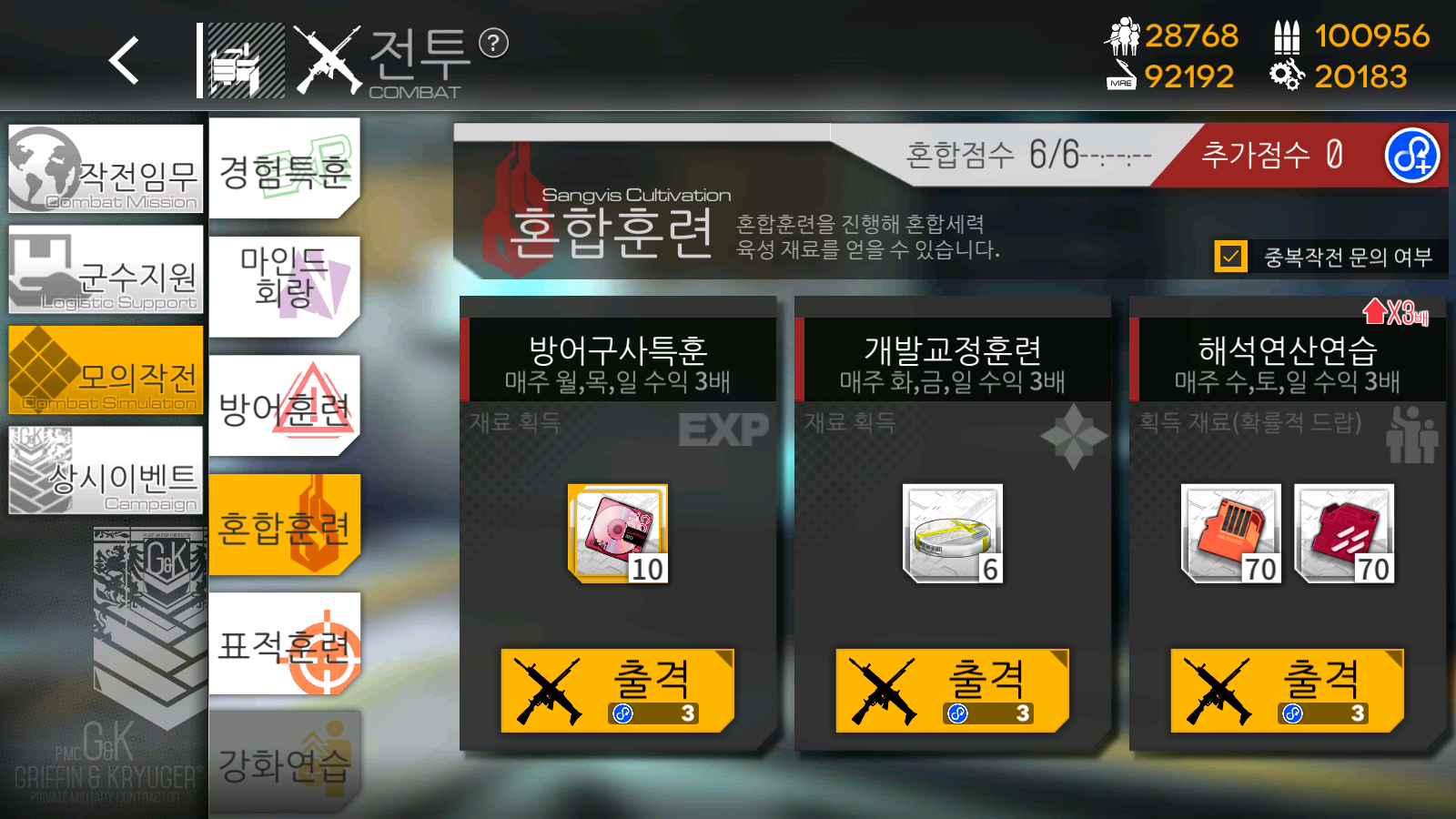
Each simulation run consumes 3 energy, so you won't be doing a ton of them per day, but as you can see, we have three different sims which are used to acquire different items. The first one is for rapid enhancing discs, the second is for petri dishes, and the third is for data. There's a 3x multiplier to one of these sims each day and Sunday (server time) has all of the sims boosted. Typically you'll want to just do the sim that's boosted.
Do note that sims are different from the normal sims. These sims force you to use a preset pool of T-Dolls that differs between each sim.
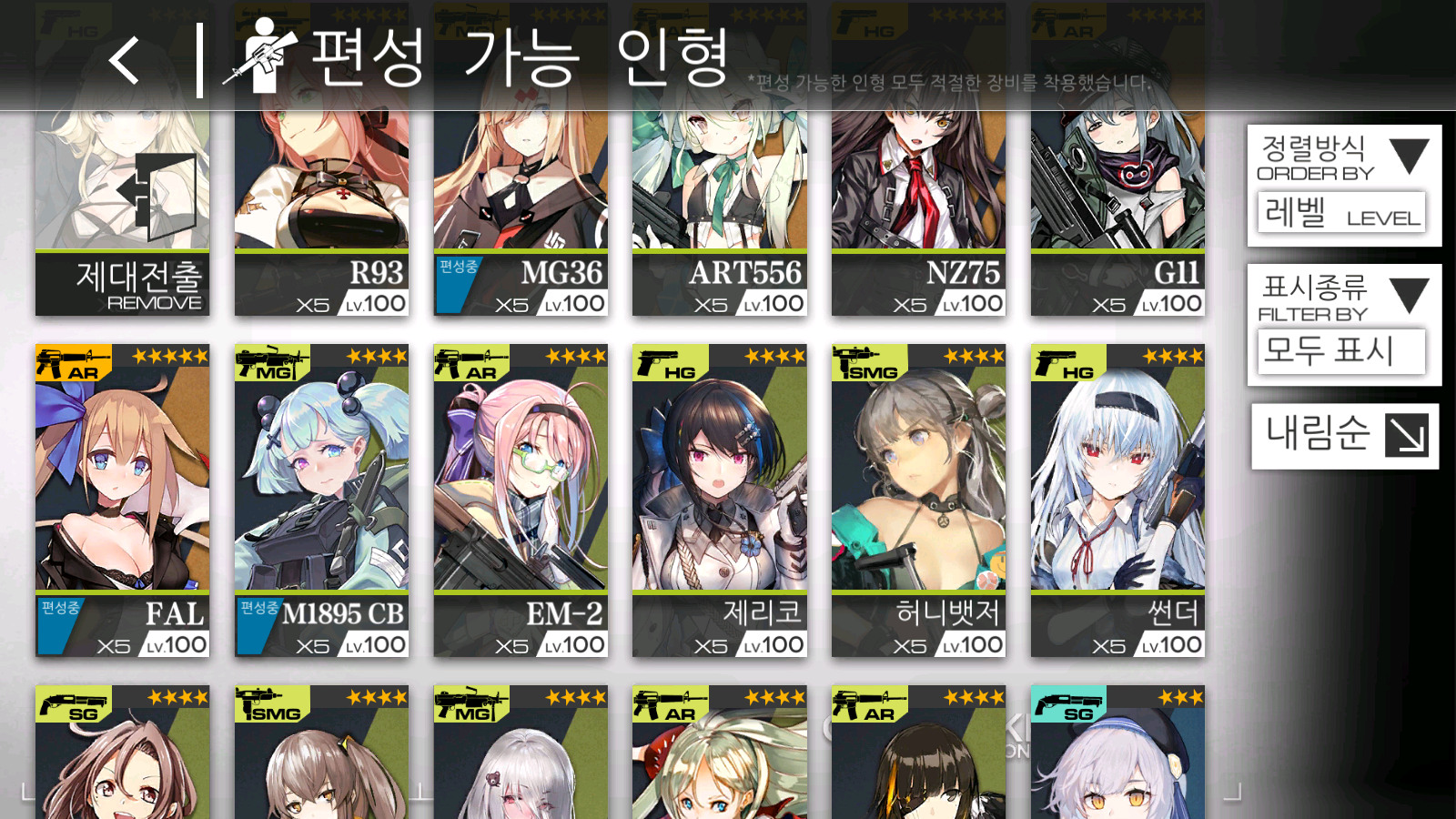
Meaning, you won't have access to all your good shit. However, the sims are designed for you to be able to clear them just fine, as the T-Dolls are properly raised and such. So, you only need to construct an echelon that can clear it.
If you can't think of anything or are too lazy, you can hit a button for the game to construct an echelon that should be able to clear it, like so:
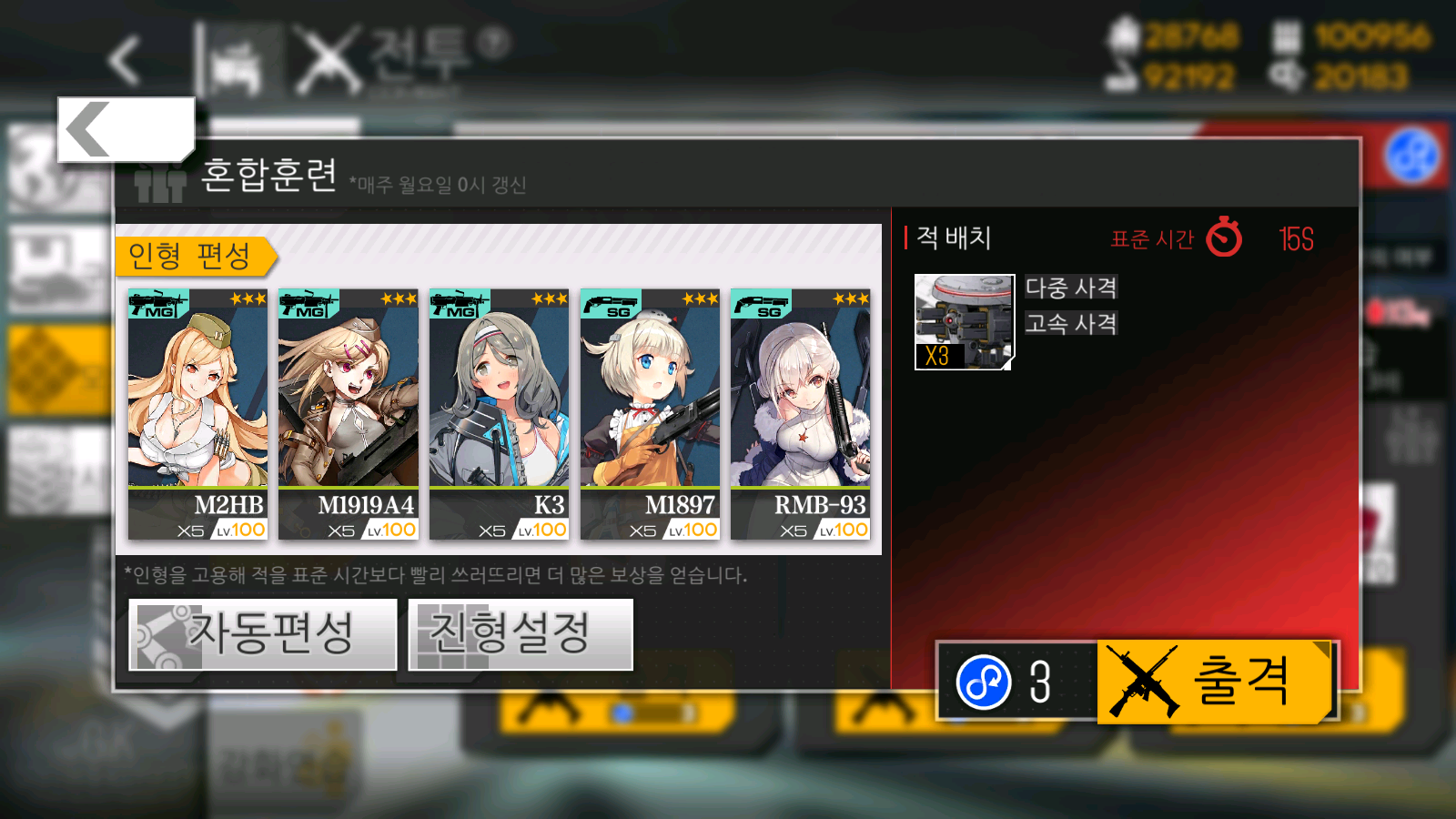
That's an automatically-generated echelon. Not the worst, especially considering the available dolls. There is a catch to this, though.
You want to go under the projected time given. If you notice on that screenshot, the time given for that set of enemies is 15 seconds. Going under that time will award you with a bonus multiplier to the resources that you gain from the sim, so do your best to construct a good echelon to clear it efficiently, or copy someone else's homework. Each sim's available pool of T-Dolls changes per week, so be prepared to make new echelons once a week for each sim.
Coalition Chips#
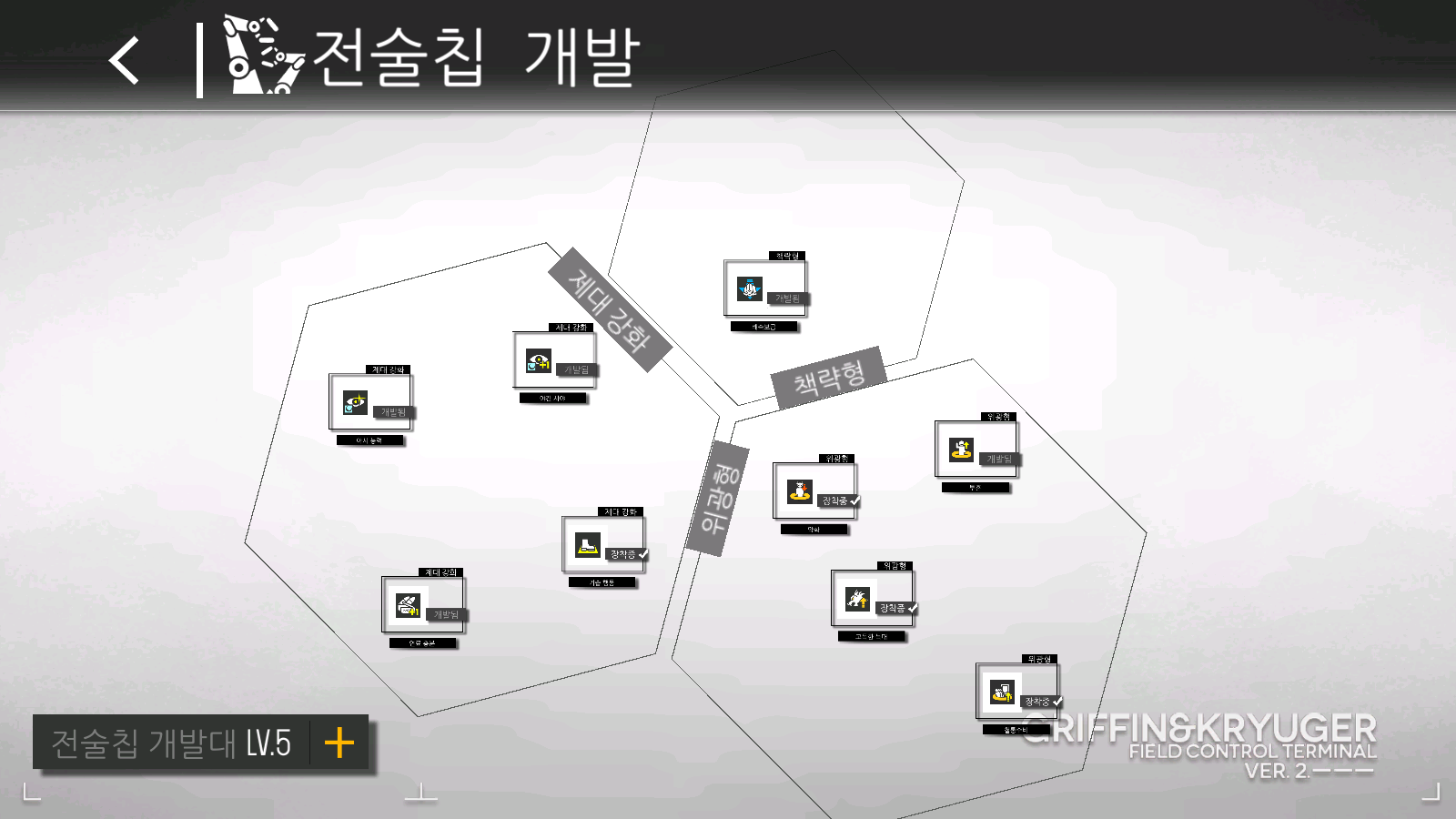
This is the inside of that tactical research station. We get a screen of different chips we'd like to research, each of which are split into three different categories. These chips can be used by ringleaders. You have access to one slot initially, but when you get the ringleader to 4*, you'll have a second slot. These chips are unique, as in, you can't dupe them. Meaning, you can only have a certain chip on one ringleader at a time. Which is a shame, because a few of these chips are extremely powerful. However, using these chips is entirely dependent on the situation, so you'll have to think about which ones you want to bring. Some commentary is provided with each chip below to aid you in figuring that out.
Chip Listing#
| Name | Battery Cost | Time Needed | Research level needed | Chip Description | Commentary |
Utility Chips# |
|||||
| Night Vision | 1,000 | 5 m | 0 | Increases vision range of an echelon with this chip at night by 1 | Nice extra utility, it's like having a permanent+passive illumination fairy. Good, depends on context though. |
| Night Vision Ability | 1,000 | 10 m | 1 | Reduces night battle accuracy penalty by 100% for this echelon | Absolutely needed if you're taking coalition units to night battles. |
| Phantom Stance | 1,000 | 30 m | 3 | The first movement in a turn by an echelon with this costs 0 AP | Insanely strong, a free movement each turn is just broken. |
| Ample Fuel | 1,000 | 1 hr | 5 | An echelon with this equipped will have an extra battle's worth of Rations/Ammo | If you need an extra battle for a strategy to work, it's insane. If not? Ha. |
Aura Chips# |
|||||
| Weaken | 1,000 | 5 m | 0 | All enemies within two nodes of an echelon with this chip receive a 12% firepower debuff in battle. | If you're using this on a support unit like Architect or Destroyer, it's basically a free debuff. Still okay even if it's not on a unit like that. It's solid. |
| Fighting Spirit | 1,000 | 5 m | 1 | All friendly echelons within 3 nodes of an echelon with this chip receive a 6% firepower buff in battle. This includes the echelon that has this chip equipped. | It's nice utility, having a 6% firepower buff for free can help with clearing deathstacks. Supposedly can affect HOCs as well, which increases its value by a good bit. |
| Lone Wolf | 1,000 | 20 m | 2 | If there are no friendly echelons adjacent to an echelon with this chip, the echelon will get a 10% firepower buff in battle. | It's a solid boost for little investment. I would pick this up pretty early. |
| Defend | 1,000 | 40 m | 4 | When fighting on a node that you have captured, an echelon with this chip will have a 100% evasion buff as well as a 50% armor buff | Can be very good if you need to defend a node for some time. |
Strategic Chips# |
|||||
| Quick Resupply | 1,000 | 1 hr | 5 | An echelon with this chip can resupply an adjacent friendly echelon using 3 AP. | This...could open up some strategies? But really, the high AP cost puts it back hard. May have some use, but I certainly haven't seen a good time to use this chip. |
Kernel Shop#
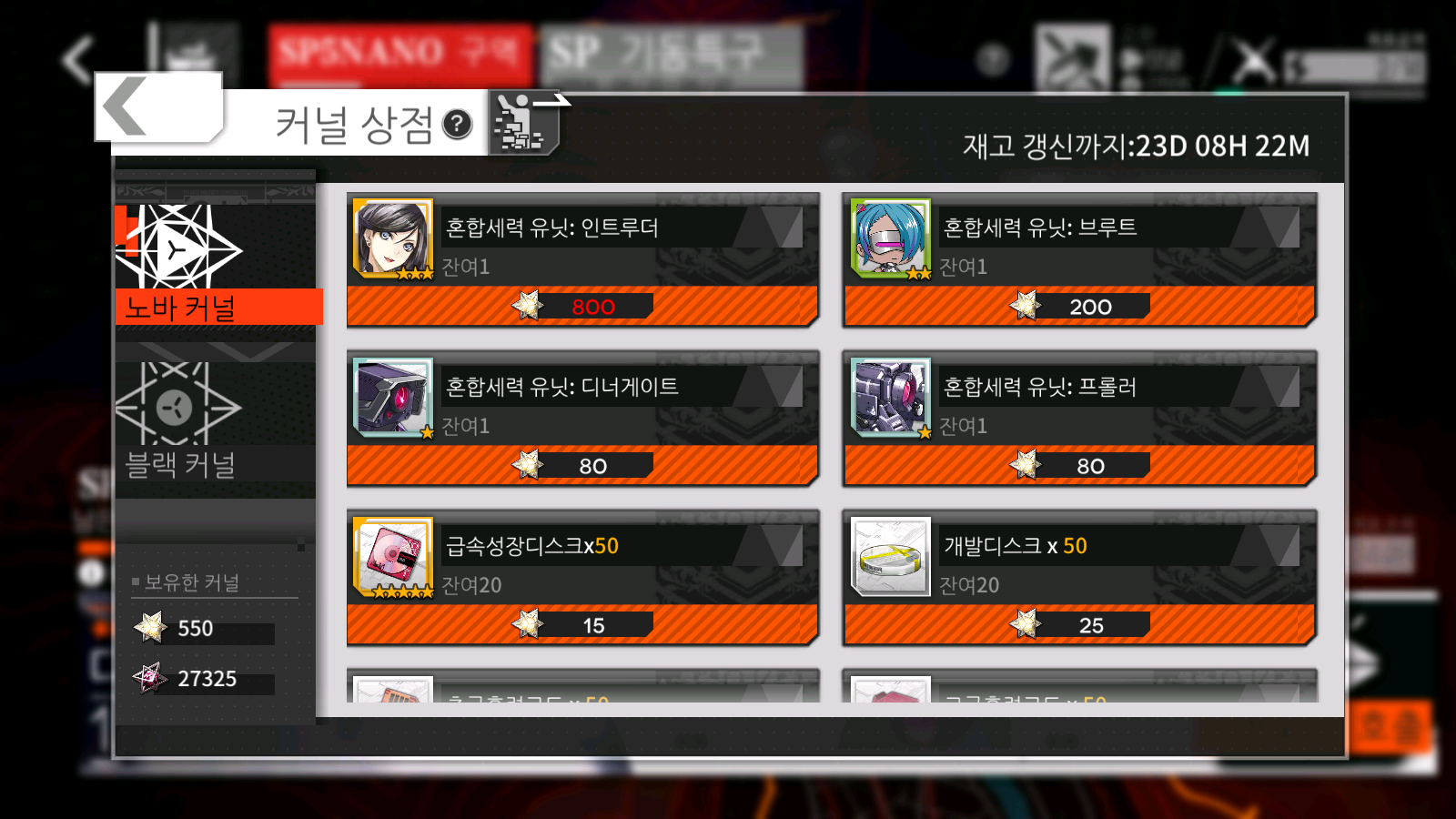
As mentioned earlier, this is where you can buy various things related to coalition capture using kernels. Kernels come from scrapping coalition units, and are split into supernova and darkstar kernels. You'll get 10 supernova kernels for scrapping a 2* base rarity coalition unit, while you'll get 100 darkstar kernels from scrapping a 1* base rarity coalition unit.
Ideally, you'll just buy materials as you need them with darkstar kernels, while saving the supernova kernels to buy a ringleader. Do note that the shop listing changes every so often. This typically involves swapping out what coalition units are obtainable, as well as the icons available. Usually, the previous pool's ringleader will be available in the shop. So if you miss it, as long as you have 800 supernova kernels, you can buy her guaranteed.
If you want some context to how many kernels you get, over the year and a half or so since this came out, I've managed to accrue over 30k darkstar kernels and almost 1.5k supernova kernels. This is entirely as a free-to-play account with some bad luck, so you can definitely pick up a ringleader through this pity mechanic if you save.
For your convenience, here's a listing of prices for things in the shop:
Supernova Kernel Listing#
| Item | Price |
| Ringleader | 800 |
|
2* Unit |
200 |
| 1* Unit | 80 |
| 50x Rapid Enhancing Disc | 15 |
| 50x Petri Dish | 25 |
| 50x Basic Training Keycode | 50 |
| 50x Advanced Training Keycode | 60 |
| 50x Transfer Catalysts | 75 |
| Ringleader Icon | 20 |
| 2* Unit Icon | 10 |
| 1* Unit Icon | 5 |
| 10x Cake | 1 |
Darkstar Kernel Listing#
| Item | Price |
| 2* Unit | 5,000 |
| 1* Unit | 2,000 |
| 50x Rapid Enhancing Disc | 375 |
| 50x Petri Dish | 625 |
| 50x Basic Training Keycode | 1250 |
| 50x Advanced Training Keycode | 1500 |
| 50x Transfer Catalysts | 1850 |
| Ringleader Icon | 500 |
| 2* Unit Icon | 250 |
| 1* Unit Icon | 125 |
| 10x Cake | 25 |
Do I dupe?#
Short answer:
Yes
Long Answer:
As is, coalition units have an extremely limited amount of different units. You're not gonna be able to field more than one good coalition echelon if you don't do some duping. So, yes, you should. Please look into how good a unit is prior to doing so. Do note that you can't dupe ringleaders.
Tldr#
Level reactor in coalition room to lv 9. Roll for units with emp pulses and don't go full mongo with your supercharge pulses and aid tickets.
Chip maker is nice to have, but not priority. Mostly just for the "equipment" of coalition units.
Do boosted combat sims for materials to develop your coalition units. Use them to actually make your units not shit. Leveling your coalition units outside of enhancing discs is stupid for now, so don't do that. Use petri dishes to rarity up and also dummy link your coalition units.
Author: Kazuki
Tags: Getting Started






